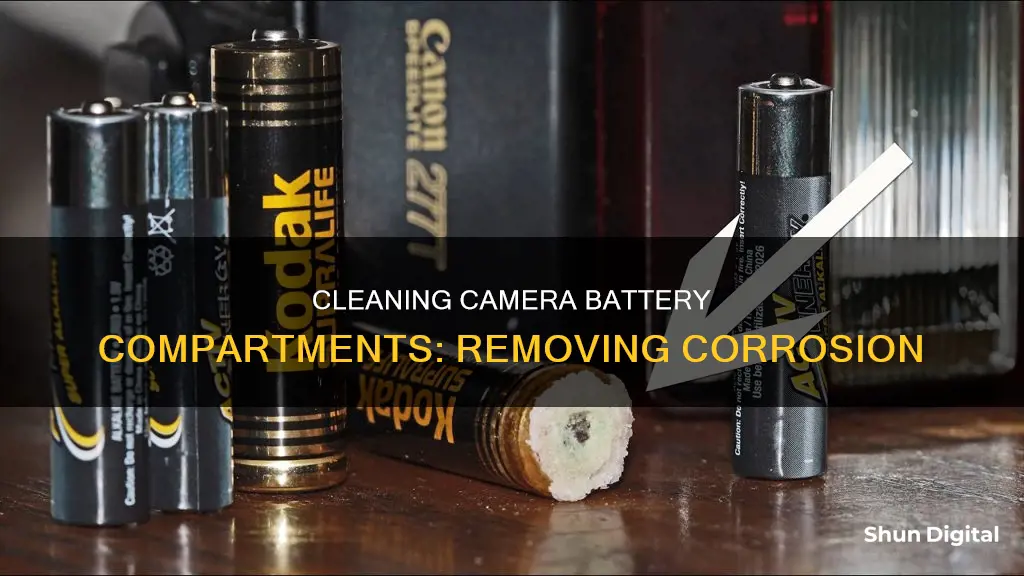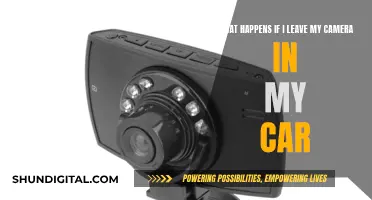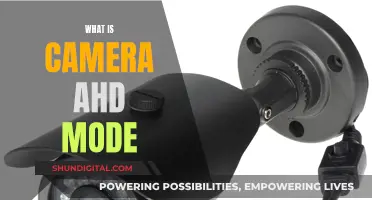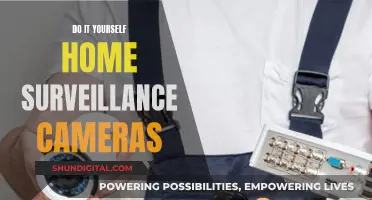
If you've left your camera unused for a while, you may find that the batteries have leaked and caused corrosion in the battery compartment. This can be fixed, and you can have your camera working again. The first step is to identify the corrosion, which usually looks like rust. Then, you can use a number of household products to clean the affected areas, including vinegar, isopropyl alcohol, and baking soda. It's important to be gentle during the cleaning process and to make sure that no liquid gets inside the camera. After cleaning, dry the area and repeat the process if necessary.
| Characteristics | Values |
|---|---|
| Tools | Q-tips/Cotton Swabs, Toothbrush, Wooden match stick/Toothpick, Fine grit sandpaper, Gloves, Face mask |
| Substances | Isopropyl Alcohol, White Vinegar, Baking Soda, Coca-Cola, Water, Lime-Away, Deoxit, Citric Acid, Apple Cider Vinegar |
| Other | Keep the camera upright, open battery door, identify corrosion with a flashlight, clean in a well-ventilated area, pat dry and let it air dry |
What You'll Learn

Use a Q-tip with vinegar to rub the affected area
To clean battery corrosion out of a camera, you can use a Q-tip with vinegar to rub the affected area. This method is effective in removing oxidation and revealing the metal underneath. However, it is important to be cautious and not use too much vinegar to avoid damaging the camera's internal components. Here's a step-by-step guide on how to do it:
- Put on protective gear: Before you begin, it's important to protect yourself from the chemicals inside the batteries. Wear rubber gloves and safety goggles or glasses to shield your skin and eyes from any harmful substances.
- Identify the corrosion: Open the battery door of your camera and use a flashlight to locate the corroded areas. Corrosion usually appears as a white, flaky, or rust-like substance on the battery terminals and contacts.
- Prepare the Q-tip: Saturate a Q-tip or cotton swab with vinegar. You can also use lemon juice as an alternative, as it has similar acidic properties.
- Gently rub the affected area: Using the vinegar-soaked Q-tip, gently rub or dab the corroded areas. You may need to use multiple Q-tips if the corrosion is widespread. Be careful not to apply too much pressure, especially on sensitive camera components.
- Allow the vinegar to work: After rubbing the corrosion with vinegar, wait for a minute or two. You should see the whitish, crusty discharge start to fizz and disintegrate due to the acidic properties of the vinegar.
- Wipe away the residue: Once the vinegar has done its job, use a clean, soft cloth or a new Q-tip to wipe away the remaining corrosion residue. Be gentle and avoid applying too much pressure on the camera's internal components.
- Repeat if necessary: If there is still some corrosion remaining or you are not satisfied with the results, you can repeat the process. Just be sure to use a new vinegar-soaked Q-tip each time.
- Dry the area: After removing the corrosion, it's important to dry the area thoroughly. Use a clean microfiber cloth or a towel to gently pat the affected parts. Make sure everything is completely dry before proceeding to the next step.
- Apply isopropyl alcohol: Once the area is dry, you can apply some isopropyl alcohol to a clean Q-tip and gently clean the affected areas again. This step will help remove any remaining residue and ensure a thorough cleaning.
- Let it dry again: After cleaning with isopropyl alcohol, let the camera dry completely. You can gently pat it down with a soft cloth to absorb any excess moisture.
- Test the camera: Finally, after everything is dry, insert new batteries and turn on the camera to see if it's working properly. If the camera still doesn't work, the corrosion may have caused more extensive damage.
Remember to work in a well-ventilated area when using vinegar, as the smell can be strong and unpleasant. Additionally, always dispose of the used Q-tips and batteries properly, following the guidelines provided by your local waste management services.
Charging Your Polaroid Z2300: A Quick Guide
You may want to see also

Use a toothbrush for larger, corroded areas
If you're dealing with larger, corroded areas, you'll need to use a toothbrush to scrub away the corrosion. This toothbrush should be an old one, as you won't be using it on your teeth again! You can also buy toothbrushes made from recycled materials at most convenience stores.
Before you start scrubbing, you'll need to make a cleaning solution. Mix a tablespoon of baking soda with one cup of warm water. You can also add a little vinegar to the mixture if you like. Put on some gloves and goggles to protect yourself from the corrosive material and the baking soda mixture.
Once you've identified the corroded areas, gently scrub the solution onto the affected parts. Be careful not to get the liquid onto any other components. If the corrosion is particularly stubborn, you may need to use a stiffer wire brush. Wipe away any remaining residue with a clean, dry cloth.
Finally, rinse the area with clean water or a damp cloth and dry it thoroughly. You can then add a small amount of petroleum jelly to the terminals to prevent future corrosion and help strengthen the connections.
Charging Your Canon Camera Battery: A Step-by-Step Guide
You may want to see also

Apply a water and baking soda mixture with Q-tips
To clean battery corrosion from your camera, you'll need to make a baking soda and water solution. Combine one tablespoon of baking soda with 32 ounces of hot water. You can also add vinegar to the mix.
Dip a Q-tip into the solution and apply it to the affected areas of your camera. Be sure to only use a small amount to avoid damaging the internals of your camera. Gently clean the corroded areas, using multiple Q-tips if necessary.
After applying the solution, use a clean towel to wipe down the camera. Repeat the process if needed. It's important to perform this task on a clean surface and to wear gloves and protective eyewear.
Charging Cameras Off-Grid: Keep Your Camera Always Ready
You may want to see also

Clean with isopropyl alcohol
To clean battery corrosion from your camera using isopropyl alcohol, you will need the following:
- Isopropyl alcohol
- Q-Tips or cotton swabs
- Rubber gloves
- A clean towel
- A well-lit, clean surface
First, open the battery door of your camera and use a flashlight to identify areas of corrosion. Corrosion usually looks like rust. Next, apply some isopropyl alcohol to a cotton swab and gently clean the affected areas. You can also use a paintbrush to apply the alcohol. Be thorough, but note that springs might be a bit tougher to clean.
After removing as much corrosion as possible, add a small amount of baking soda to the areas. Then, apply some vinegar to a clean cotton swab and drip it onto the baking soda. Be careful not to use too much vinegar, as you could destroy the internals of your camera.
Once you have finished applying vinegar, clean the area with a towel. Then, give it another pass with isopropyl alcohol to remove any remaining residue. Finally, let the camera dry completely before replacing the batteries and turning it on.
Isopropyl alcohol is a safe and effective way to clean electronics without leaving behind moisture or residue. It is also useful for displacing any leftover water, depending on where the contacts are situated. For best results, use the purest form of isopropyl alcohol you can find (90-99% concentration).
Doorbell Camera Battery Options: External Power Source?
You may want to see also

Rinse with water and dry
Once you have applied vinegar or lemon juice to the corroded area and wiped away the corrosion, it is important to rinse the area with water and dry it thoroughly.
For this step, you will need a fresh cotton swab, some clean water, a pencil eraser, and a microfiber cloth. You may also need some compressed gas.
Dip the cotton swab into the water and gently clean any residue on the contacts or in the battery compartment. Use the pencil eraser to polish the surfaces. Dry the area with the microfiber cloth and blow away any fibres. You can use compressed gas for hard-to-dislodge debris.
Let everything dry completely before installing fresh batteries and powering up your camera.
Activeon Action Camera: Swappable Batteries?
You may want to see also
Frequently asked questions
Vinegar, lime-away, Coca-Cola, baking soda, and isopropyl alcohol can all be used to clean a corroded camera battery.
Q-tips, toothbrushes, and cotton swabs can be used to clean a corroded camera battery.
It is important to keep the camera upright while cleaning to prevent liquid from dripping inside. Gloves should be worn when handling corrosive substances, and it is recommended to use a mask when working with dried-up battery acid.
Corrosion in a camera battery usually looks like rust.







